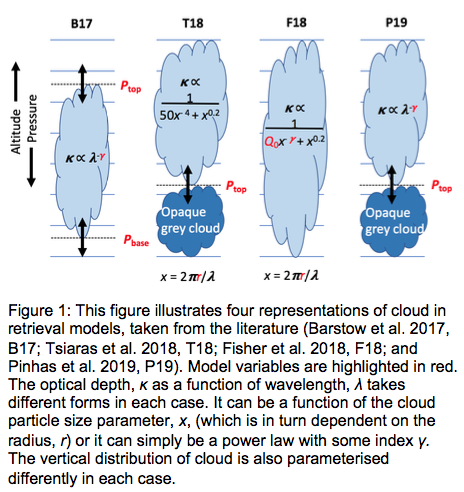Unveiling cloudy exoplanets: the influence of cloud model choices on retrieval solutions
- The Open University, School of Physical Sciences, Milton Keynes, United Kingdom of Great Britain and Northern Ireland (jo.barstow@open.ac.uk)
A substantial fraction of transiting exoplanets have some form of aerosol present in their atmospheres. Transit spectroscopy, especially of hot Jupiters, has provided evidence for this, in the form of steep downward slopes from blue to red in the optical part of the spectrum, and muted gas absorption features throughout. Studies analysing the atmospheres of these planets must therefore consider the presence of aerosol.
However, clouds and hazes are complex, and the transit spectra that are currently available allow us to constrain only limited properties of cloud and haze. Retrieval models – fast, parametric radiative transfer models coupled with an inversion algorithm – are typically used to analyse transit spectra, but these rely on minimising the number of variables to ensure rapid convergence. Optimising aerosol parameters to maximise constraints on cloud structure, whilst avoiding overfitting, is therefore a necessary step.
In this presentation, I investigate a range of aerosol parameterisations from the literature (Figure 1), and examine their effects on retrievals from transmission spectra of hot Jupiters HD 189733b (Figure 2) and HD 209458b. Regardless of the parameterisation used, results qualitatively agree for the cloud/haze itself, and using multiple approaches provides a more holistic picture. The retrieved H2O abundance is also robust to assumptions about aerosols. Additionally, strong evidence emerges that aerosol on HD 209458b covers less than half of the terminator region, but the situation for HD 189733b is less clear (Barstow 2020).

References:
Barstow J. K., Aigrain S., Irwin P. G. J., Sing D. K., 2017, ApJ, 834, 50
Barstow J. K., 2020, arxiv:2002.02945
Fisher C., Heng K., 2018, MNRAS, 481, 4698
Pinhas A., Madhusudhan N., Gandhi S., MacDonald R., 2019, MNRAS, 482, 1485
Sing D. K., et al., 2016, Nature, 529, 59
Tsiaras A., et al., 2018, AJ, 155, 156
How to cite: Barstow, J.: Unveiling cloudy exoplanets: the influence of cloud model choices on retrieval solutions, Europlanet Science Congress 2020, online, 21 September–9 Oct 2020, EPSC2020-132, https://doi.org/10.5194/epsc2020-132, 2020

